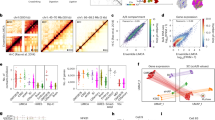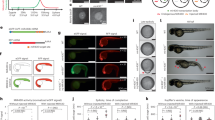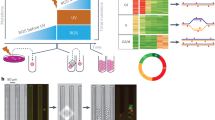Abstract
The reprogramming of X-chromosome inactivation during the acquisition of pluripotency in vivo and in vitro1 is accompanied by the repression of Xist2, the trigger of X-inactivation3, and the upregulation of its antisense counterpart Tsix4. We have shown that key factors supporting pluripotency—Nanog, Oct4 and Sox2—bind within Xist intron 1 in undifferentiated embryonic stem cells (ESC) to repress Xist transcription5. However, the relationship between transcription factors of the pluripotency network and Tsix regulation has remained unclear5,6. Here we show that Tsix upregulation in embryonic stem cells depends on the recruitment of the pluripotent marker Rex1, and of the reprogramming-associated factors Klf4 and c-Myc, by the DXPas34 minisatellite associated with the Tsix promoter. Upon deletion of DXPas34, binding of the three factors is abrogated and the transcriptional machinery is no longer efficiently recruited to the Tsix promoter. Additional analyses including knockdown experiments further demonstrate that Rex1 is critically important for efficient transcription elongation of Tsix. Hence, distinct embryonic-stem-cell-specific complexes couple X-inactivation reprogramming and pluripotency, with Nanog, Oct4 and Sox2 repressing Xist to facilitate the reactivation of the inactive X, and Klf4, c-Myc and Rex1 activating Tsix to remodel Xist chromatin7,8,9,10 and ensure random X-inactivation upon differentiation1. The holistic pattern of Xist/Tsix regulation by pluripotent factors that we have identified suggests a general direct governance of complex epigenetic processes by the machinery dedicated to pluripotency.
This is a preview of subscription content, access via your institution
Access options
Subscribe to this journal
Receive 51 print issues and online access
$199.00 per year
only $3.90 per issue
Buy this article
- Purchase on Springer Link
- Instant access to full article PDF
Prices may be subject to local taxes which are calculated during checkout



Similar content being viewed by others
References
Navarro, P. & Avner, P. When X-inactivation meets pluripotency: an intimate rendezvous. FEBS Lett. 583, 1721–1727 (2009)
Borsani, G. et al. Characterization of a murine gene expressed from the inactive X chromosome. Nature 351, 325–329 (1991)
Penny, G. D. et al. Requirement for Xist in X chromosome inactivation. Nature 379, 131–137 (1996)
Lee, J. T., Davidow, L. S. & Warshawsky, D. Tsix, a gene antisense to Xist at the X-inactivation centre. Nature Genet. 21, 400–404 (1999)
Navarro, P. et al. Molecular coupling of Xist regulation and pluripotency. Science 321, 1693–1695 (2008)
Donohoe, M. E. et al. The pluripotency factor Oct4 interacts with Ctcf and also controls X-chromosome pairing and counting. Nature 460, 128–132 (2009)
Navarro, P. et al. A role for non-coding Tsix transcription in partitioning chromatin domains within the mouse X-inactivation centre. Epigenetics Chromatin 2, 8 (2009)
Navarro, P., Page, D. R., Avner, P. & Rougeulle, C. Tsix-mediated epigenetic switch of a CTCF-flanked region of the Xist promoter determines the Xist transcription program. Genes Dev. 20, 2787–2792 (2006)
Navarro, P. et al. Tsix transcription across the Xist gene alters chromatin conformation without affecting Xist transcription: implications for X-chromosome inactivation. Genes Dev. 19, 1474–1484 (2005)
Sado, T., Hoki, Y. & Sasaki, H. Tsix silences Xist through modification of chromatin structure. Dev. Cell 9, 159–165 (2005)
Mak, W. et al. Reactivation of the paternal X chromosome in early mouse embryos. Science 303, 666–669 (2004)
Okamoto, I., Otte, A. P., Allis, C. D., Reinberg, D. & Heard, E. Epigenetic dynamics of imprinted X inactivation during early mouse development. Science 303, 664–666 (2004)
Takahashi, K. & Yamanaka, S. Induction of pluripotent stem cells from mouse embryonic and adult fibroblast cultures by defined factors. Cell 126, 663–676 (2006)
Maherali, N. et al. Directly reprogrammed fibroblasts show global epigenetic remodeling and widespread tissue contribution. Cell Stem Cell 1, 55–70 (2007)
Chambers, I. & Tomlinson, S. R. The transcriptional foundation of pluripotency. Development 136, 2311–2322 (2009)
Navarro, P. & Avner, P. An embryonic story: analysis of the gene regulative network controlling Xist expression in mouse embryonic stem cells. Bioessays 32, 581–588 (2010)
Vigneau, S. et al. An essential role for the DXPas34 tandem repeat and Tsix transcription in the counting process of X chromosome inactivation. Proc. Natl Acad. Sci. USA 103, 7390–7395 (2006)
Ogawa, Y. & Lee, J. T. Xite, X-inactivation intergenic transcription elements that regulate the probability of choice. Mol. Cell 11, 731–743 (2003)
Stavropoulos, N., Rowntree, R. K. & Lee, J. T. Identification of developmentally specific enhancers for Tsix in the regulation of X chromosome inactivation. Mol. Cell. Biol. 25, 2757–2769 (2005)
Masui, S. et al. Rex1/Zfp42 is dispensable for pluripotency in mouse ES cells. BMC Dev. Biol. 8, 45 (2008)
Silva, J. et al. Promotion of reprogramming to ground state pluripotency by signal inhibition. PLoS Biol. 6, e253 (2008)
Niwa, H., Miyazaki, J. & Smith, A. G. Quantitative expression of Oct-3/4 defines differentiation, dedifferentiation or self-renewal of ES cells. Nature Genet. 24, 372–376 (2000)
Kouzarides, T. Chromatin modifications and their function. Cell 128, 693–705 (2007)
Guttman, M. et al. Chromatin signature reveals over a thousand highly conserved large non-coding RNAs in mammals. Nature 458, 223–227 (2009)
Rahl, P. B. et al. c-Myc regulates transcriptional pause release. Cell 141, 432–445 (2010)
Kim, J. et al. An extended transcriptional network for pluripotency of embryonic stem cells. Cell 132, 1049–1061 (2008)
Kim, J. D., Faulk, C. & Kim, J. Retroposition and evolution of the DNA-binding motifs of YY1, YY2 and REX1. Nucleic Acids Res. 35, 3442–3452 (2007)
Chen, X. et al. Integration of external signaling pathways with the core transcriptional network in embryonic stem cells. Cell 133, 1106–1117 (2008)
Jonkers, I. et al. RNF12 is an X-Encoded dose-dependent activator of X chromosome inactivation. Cell 139, 999–1011 (2009)
Stadtfeld, M. et al. Aberrant silencing of imprinted genes on chromosome 12qF1 in mouse induced pluripotent stem cells. Nature 465, 175–181 (2010)
Acknowledgements
We thank P. Clerc for discussions. P.N. was initially supported by recurrent funding from the Institut Pasteur and then by the Royal Society (a Newton International Fellowship). P.A. was supported by recurrent funding from the Centre National de la Recherche Scientifique and the Institut Pasteur, contracts 05-JCJC-0166-01 and 07-BLAN-0047-01 from the Agence Nationale de la Recherche and funding from the EU Epigenome Network of Excellence. C.R. was supported by the INSERM ‘Avenir’ programme and by the European Research Council ‘starting grant’ programme. Research in I.C.’s laboratory was supported by the Wellcome Trust, by the EU Framework 7 project “EuroSyStem” and by a Medical Research Council studentship (to N.F.).
Author information
Authors and Affiliations
Contributions
P.N. conceived the study, designed, performed and analysed the experiments, and co-wrote the manuscript. A.O., J.L., N.F., M.A. and A.D. provided technical help. C.R., I.C. and P.A. provided financial and conceptual support. P.A. conceived the study and co-wrote the manuscript. All authors read and approved the final manuscript.
Corresponding authors
Ethics declarations
Competing interests
The authors declare no competing financial interests.
Supplementary information
Supplementary Information
This file contains Supplementary Figures 1-8 with legends and additional references. (PDF 503 kb)
Rights and permissions
About this article
Cite this article
Navarro, P., Oldfield, A., Legoupi, J. et al. Molecular coupling of Tsix regulation and pluripotency. Nature 468, 457–460 (2010). https://doi.org/10.1038/nature09496
Received:
Accepted:
Published:
Issue Date:
DOI: https://doi.org/10.1038/nature09496
This article is cited by
-
GATA transcription factors drive initial Xist upregulation after fertilization through direct activation of long-range enhancers
Nature Cell Biology (2023)
-
CasTuner is a degron and CRISPR/Cas-based toolkit for analog tuning of endogenous gene expression
Nature Communications (2023)
-
Gene regulation in time and space during X-chromosome inactivation
Nature Reviews Molecular Cell Biology (2022)
-
Integrated analysis of Xist upregulation and X-chromosome inactivation with single-cell and single-allele resolution
Nature Communications (2021)
-
SPEN is required for Xist upregulation during initiation of X chromosome inactivation
Nature Communications (2021)
Comments
By submitting a comment you agree to abide by our Terms and Community Guidelines. If you find something abusive or that does not comply with our terms or guidelines please flag it as inappropriate.



